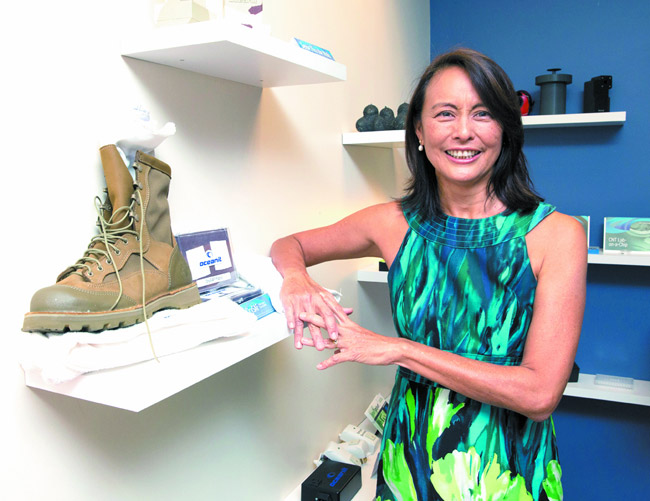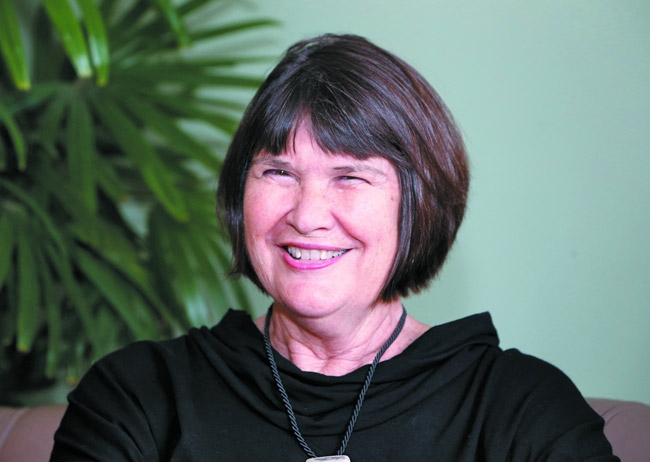Saluting Women With STEM Success
The Girl Scouts’ annual Woman of Distinction dinner honors three who are succeeding in male-dominated professions
It’s a quest that begins the moment we are born, and a question we hear before we are even able to hold a conversation: What would you like to be when you grow up?
As children, our aspirations may have been large and overzealous – especially for those who imagined themselves future super-heroes. Nevertheless, they were innocent fantasies that knew no limitations.
It is this belief in an endless amount of opportunities that Girl Scouts of Hawaii hopes to instill in its participants, grades K-12, along with building the courage, confidence and character of each girl.
“That’s what we’re trying to do – help girls not to limit themselves, but to understand who they are, what they’re capable of doing,” says Gail Mukaihata Hannemann, Girl Scouts of Hawaii chief executive officer.
For girls interested in STEM – science, technology, engineering and math – limitless possibilities have not been always easily available.
Research done by Girl Scouts of the USA discovered that girls who engage in STEM through both reading and practical things like stem toys do well in school and other areas, but their curiosity tends to dissipate once they enter middle school.
“What they saw was that girls cannot see how the STEM field helps them realize their dreams and aspirations,” says Mukaihata Hannemann.
Recently, eight high school Girl Scouts sent a hydroponic plant to the International Space Station after developing methods to ensure its sustainability in space.
They join a short list of other high school students across the nation who have sent something to space.
It is these types of initiatives the organization hopes to continue to make available for its girls.
Annually, the organization honors recipients of its Woman of Distinction award. Appropriately, this year’s theme is STEM.
This year’s honorees – Dr. Elizabeth M. Ignacio, Sheryl B. Seaman and Jan N. Sullivan – represent vastly different fields. All are STEM-related and represent the intricate ties STEM has in nearly any occupation.
“What we wanted to show by looking at these women were different ways of how to apply those things,” says Mukaihata Hannemann.
The Nov. 13 dinner also will include approximately 200 Girl Scouts assisting with the event. During the evening, girls also will have a chance to engage in discussion with the night’s honorees.
“Professionally, they’re outstanding women in their field,” says Mukaihata Hannemann, “but they have big hearts and do really great things for the community.”
The woman who always knew
Aside from a brief interest at the age of 5 of one day entering the World Wrestling Federation, all Elizabeth M. Ignacio ever wanted to become was a doctor. She just never imagined orthopedic surgery would become her speciality.
Born in the Philippines to a mother who was a doctor, her professional pursuits became a natural path.
As a third-year medical student doing rotations through different specialities, orthopedic surgery was the most grueling. But it was also the most fun.
“It’s truly a vocation, it’s a calling,” she says. “When you find that in your life, then your work becomes play.”
Ignacio currently serves as an assistant professor of surgery at John A. Burns School of Medicine at the University of Hawaii. She also is the volunteer physician and orthopedic consultant for the UH Athletics Department.
In January, she opened IMUA, a clinic for orthopedic and sports medicine.
With many different hats to wear day-to-day, Ignacio identifies most with being a mother. Her 9-year-old daughter happens to be a Girl Scout who will be assisting at the event.
For someone whose profession is dominated by males (96 percent), Ignacio is aware that she represents a minority. But it also is a role she embraces, and it’s an example she believes may be applied to all young people.
“Think outside the box,” she says. “Expose yourself to as many things, find your passion, don’t let others stereotype or define you. You define yourself.”
The woman who was told ‘no’
When Sheryl B. Seaman was in ninth grade, she was tasked with completing an assignment that required her to research the career she aspired to pursue. At the time, it was architecture.
“The teacher said, ‘Girls cannot write about architecture, you have to do one on nursing,'” she says.
She had always had a knack for math and sciences, and enjoyed the creativity architecture allowed. Though her teacher’s discouragement briefly deterred her, it wasn’t enough to keep her away.
Today, Seaman serves as vice chairman of Group 70 International, a design firm, where she has worked for 35 years doing planning, interior design and, yes, architecture.
After reading an article that stated approximately 90 percent of a person’s time is spent indoors, Seaman developed a desire to understand the impact interior spaces have on daily life. It has allowed her to successfully launch a design group within Group 70 International and begin a furniture business based in New York with her daughter.
“Having two jobs keeps me off the street and out of trouble,” she says, laughing.
When Seaman first began studying architecture, there typically was only one female in each class. Now, she says, that number has increased to about 50-60 percent women.
In a field as creative as STEM, Seaman says it is important to be open to criticism.
“When someone critiques you, don’t take it personally, and don’t take it as a symptom of adversity,” she says, “because I have learned a lot from people who were critical of me over time.”
The woman who changed careers
Twenty-eight years ago, Jan N. Sullivan had just begun her law career when husband Patrick founded Oceanit, a science and engineering company.
Longing for something else, Sullivan eventually left her career in law.
“At some point, I matured to the point where I decided that I wanted to do something that made a difference,” says Sullivan.
She was then asked by the mayor to run the planning department, and became the first female chief planning officer for the City and County of Honolulu.
During her three years there, she oversaw the reorganization of what is now known as the Department of Planning and Permitting.
Throughout those years, Oceanit grew into what is now one of the largest science and engineering companies on the island.
After leaving DPP, she decided to help her husband in what initially began as a part-time job. It has been more than 10 years since, and Sullivan now serves as the executive vice president and chief operating officer of Oceanit.
“It’s worked out to be surprisingly good,” she says,
As a leading company in the nation, Sullivan credits much of that success to a willingness to embrace failure, a trait she says ties in with the Girl Scouts’ desire to instill courage and confidence in its participants.
“Risk-taking and innovation are encouraged, crazy ideas are encouraged, trying things that nobody thinks will work is encouraged,” she says, “and it’s OK. Sometimes it works, sometimes it doesn’t, but that’s what it takes to really create an environment where people can be collaborative and innovative.”
Women who believe in STEM
Regardless of stereotypes associated with STEM, it really is in everything.
“If you remove yourself from those boundaries, it’s amazing how you can find science, technology, engineering, architecture, math in everyday life,” she says.
Collectively, this year’s honorees appreciate the efforts of the Girl Scouts to emphasize the importance of STEM education and to make its exploration possible for the girls.
“Their goals are very much in alignment with what I see we actually need to develop for women who are going into STEM careers,” says Sullivan.
Individual tickets for the Nov. 13 dinner at Hilton Hawaiian Village are still available. For more information, visit girlscouts-hawaii.org.







